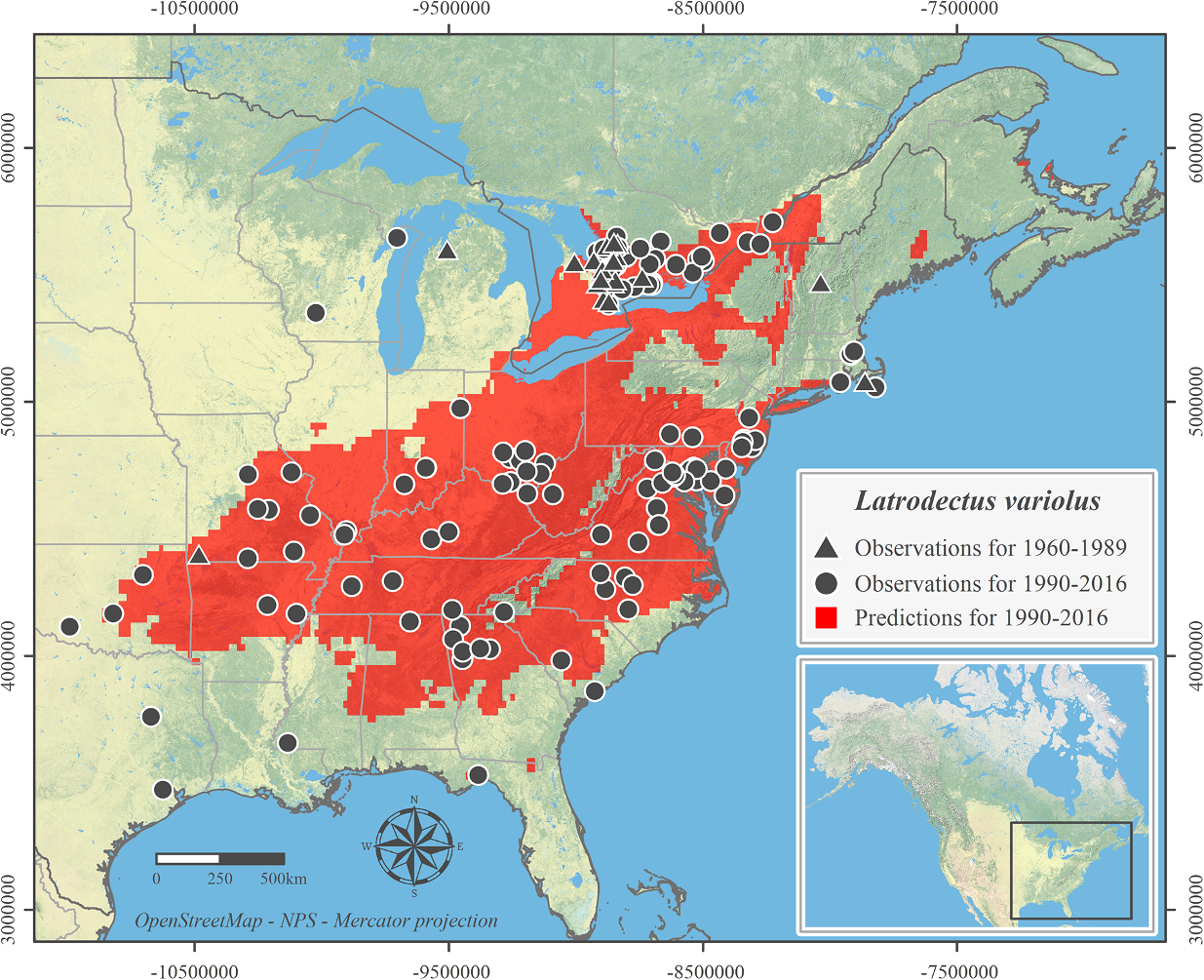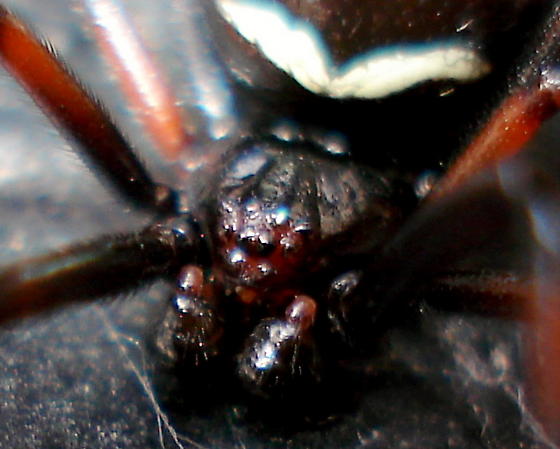- Researchers paired museum collection information for two species of spiders, dating back several decades, with more recent information from online citizen science databases and compared them to climate data to find areas with conditions suitable for each species.
- They developed maps of predicted geographic distributions for each species and, despite limited data, their findings suggest ranges of both species have shifted northward over time.
- The researchers highlight the importance of citizen science data in generating long-term data sets on species distributions.
Changing climate has already affected where some species live. To determine how changes in temperature and rainfall patterns may affect a given plant or animal, researchers need to know where the species used to live and where it lives now.
Such geographic distribution data help scientists understand a species’ habitat requirements and vulnerability to environmental changes, but they are lacking for many species, especially smaller or less-well-studied ones.
Now, though, a new study has demonstrated how the recent availability of online citizen science data may be able to help scientists fill these data gaps to better understand and map species distributions.

Researchers have traditionally approximated the ranges of plants and animals from collection locations of specimens in museums, private collections and historical literature. But with millions of species and relatively few field scientists, museum data are incomplete: they include only a handful of records for a species, they lack the geographic location of some collection sites, or they pertain to specimens collected decades ago. This is especially true for invertebrates such as insects and other arthropods.
Scientists may, therefore, know that a certain species has been found in a few discrete locations, but not how it is distributed across the landscape or where it has been detected since climate shifts have been measured.
Help may be on the way, in the form of citizen science, specifically the increasingly popular online amateur naturalist platforms.
“Distributions of spiders are relatively poorly known, and range maps are often based just on where scientists have found the species,” said the current study’s lead author, Yifu Wang, in a statement. “Using northern black widow spider and black purse-web spider as examples, this paper illustrates that we can (and should!) incorporate citizen science data and distribution modeling techniques to help bridge the knowledge gaps of less-studied species.”
Museum collections meet internet citizen scientists
Online natural history platforms allow researchers and amateur naturalists alike to upload photos and observation data and receive help from the observer community and regional experts in identifying the species. The tens of thousands of participants on these platforms, who far exceed the small cadre of professional field scientists, produce many thousands of annotated, spatially explicit images and records that researchers have begun to use for mapping species.
These online data sets are all relatively new, and so their time frame complements that of most museum data. Wang and her colleagues incorporated data generated on internet-based data platforms by researchers, through the Global Biodiversity Information Facility (established in 2001) and Encyclopedia of Life (2008), and citizen scientists, through eBird (2002), eButterfly (2012), iNaturalist (2008), and Bugguide (2004).
Wang and her colleagues assessed whether they could successfully match the locations of records collected from museums, research centers, literature, personal collections and the online biodiversity information databases with 55 years of climate data to create models of the geographic distributions of two poorly documented spider species in North America: the northern black widow (Latrodectus variolus) and the black purse-web spider (Sphodros niger).
 |
 |
| Spiders on the move: a black purse-web spider on the ground in Virginia, USA on left (image by Robbin D. Knapp via Flickr CC 2.0) and a northern black widow spider in dead leaves on right (image by Sean McCann). | |
Wang told Mongabay-Wildtech that they verified the species’ identifications in the citizen science records by visually reviewing the pictures provided by observers and removing the ones that might be misidentified or might be pets.
“We believe museum data are quite reliable because these two species are not hard to identify through body features, especially for experts,” Wang said, “which is also why we can identify people’s observation through photos they provide.”
The researchers mapped the location records using a 10-kilometer (6-mile) cell grid for which they had information on temperature and precipitation in different seasons throughout the study period. They therefore also excluded all species location records with a geographic uncertainty greater than 10 kilometers. They developed models of the climatic conditions in which each species is likely to be found, using software that compared the known locations of the species with the climate information in each grid cell.
They used a variety of statistical tools to quantify how well a model fits actual data and verify the validity of their final range prediction model. For example, the models incorporated parameters that considered both the identification errors and the uneven geographic distribution of the citizen science observations.
“Our models have very high [verification test] values, indicating that they are well-performed models,” Wang said. “In addition, we consulted spider experts to ask if our maps make sense based on their expertise.”
Moving North
With recent studies suggesting that ranges of similar species are expanding northward, the researchers applied the species location and climate data to determine whether the zones of suitable climate and environment had changed in recent years.
They compared the current range predicted by their models to the predicted historical range to test whether the ranges had shifted over time.
The modeled historic distribution overlapped substantially with the modeled current distribution for the black purse-web spider, though the results suggest this species’ range may have shifted since 1960, not only expanding along the northern edge in Canada but also contracting in the southwest corner (including Arkansas, Missouri and Tennessee).

The northern edge of the black widow’s range may also have increased over time, though with just 22 historic mapped observations of the black widow, however, the researchers could not create a verifiable model of its historic distribution.
“We tried to quantify the [purse-web spider range] shift by calculating the mean difference between the two northern edges,” Wang said, “but the result had a very high standard deviation, i.e. not valid. For L. variolus [northern black widow], since the historical model was not successful, we compared the northern-most records of the two periods and found there is a shift, but of course, this is just an empirical result without statistical tests.”
“This data deficiency-induced failure,” the researchers state in their paper, “further reinforces the necessity of digitalizing all available historical records and the incorporation of citizen science data for studying poorly-documented species.”

The most important environmental factor determining predicted current range for the purse-web spider was the average temperature of the coldest three months of the year. In contrast, for the black widow, the average temperature of the warmest three months most influenced its predicted current range.
The researchers suspect that habitat requirements of the two species may explain the different environmental drivers in their models. The purse-web spider specializes in open dry sandy and rocky woodland areas that might make escaping cold winter temperatures difficult, so the temperatures during the coldest quarter of the year could limit their distribution.

The northern black widow often uses man-made shelters to escape cold, but its relatively high metabolic rate, a trait that enables it to withstand cold environments, might be a disadvantage in the heat and could make the temperatures of the year’s warmest quarter a limiting factor.
The researchers credit citizen scientists for providing the species location and calendar data that were integral to all of these analyses.
Vetting is essential for reliable data
Helpfully, internet-based citizen science databases usually include some vetting by the observer community and regional experts.
According to the researchers, observations submitted to certain citizen science platforms such as eBird and eButterfly are vetted by regional experts who validate the precision of geographic coordinates, the observation date and the species, correcting species identification when appropriate. On other platforms, such as iNaturalist and Bugguide, the observer community self-controls the quality of identifications (crowd-source identification). Potential misidentifications are moved to a special forum where experts can confirm the identification.
Nevertheless, these data may still need careful vetting by scientists wanting to use them for research. For the current study, for example, the researchers reviewed the species in each of the many images attributed to the species of interest, and they filtered out records with uncertain geographic locations. Citizen science data is generally more accurate for species with easily identified features, such as shapes or colors, say the researchers.

Wang suggested that citizen scientists who want to upload photos to one of these online platforms can best assist scientists by taking photos from multiple angles, as amateur naturalists may not know which body features scientists use to identify different species. “If possible,” Wang said, “a size reference would be helpful as well, for example a coin besides the animal. Geographic location is crucial for the data to be scientifically valuable and useful, and more accurate would be better.”
Citation
Wang, Y., Casajus, N., Buddle, C., Berteaux, D., & Larrivée, M. (2018). Predicting the distribution of poorly-documented species, Northern black widow (Latrodectus variolus) and Black purse-web spider (Sphodros niger), using museum specimens and citizen science data. PloS one, 13(8), e0201094.
FEEDBACK: Use this form to send a message to the editor of this post. If you want to post a public comment, you can do that at the bottom of the page.